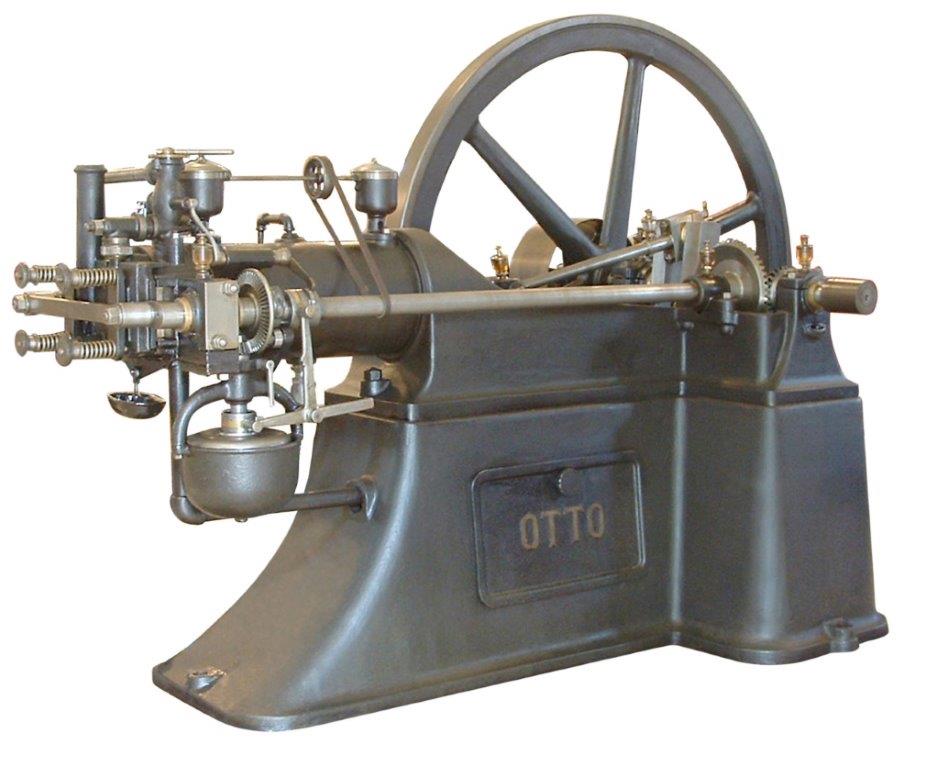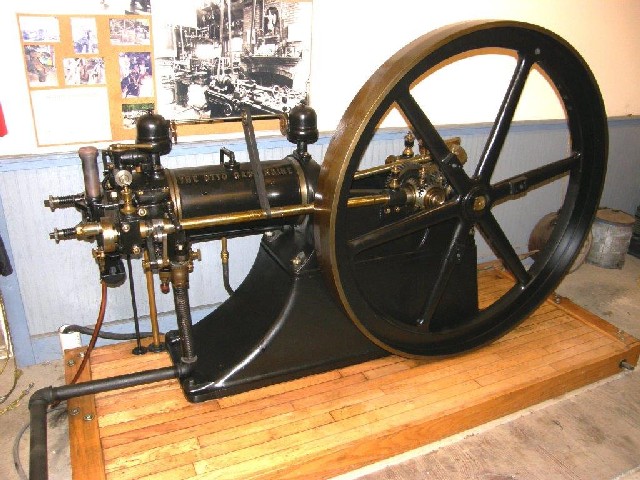|

June 2015
Flame Ignition Engines
By Paul Harvey
As the summer solstice approaches,
Coolspring Power
Museum is preparing for its magnificent
Thirtieth Anniversary Celebration, the Flame Ignition Expo. This
promises to be our largest event ever! As an unprecedented gathering of
the rarest flame ignition and centennial engines from across
North America, it will be the largest and most significant
event of its kind ever shown. The dates are June 18, 19, and 20,
2015. Indeed, it will be a much larger version of our Centennial Engine
Expo of 1995.
The museum has worked diligently for the past year to
make this great show possible. Monumentally, a new, climate controlled
structure has been erected, thanks to our generous donors. Joined to
the Susong
Building, it will double its size and
initially be used to house some of our exhibitors' most prized
possessions. Designed by our late Curator of Collections, Preston Foster, it will be
dedicated to his memory during the show as The Preston Foster Hall.
Photo 1 shows Preston, his faithful
Husky, Kanu, and one of his beloved Foos engines. He is sadly missed by
the museum, his friends, and the entire gas engine world.
We expect about forty flame ignition engines from all over the United
States and
Canada to arrive for display and operation at the event.
These will range from machines weighing several tons to toy engines.
All will have been built before 1900, and many in the 1870s and
1880s. They will be displayed in three prime locations to give the
visitor easy access, as most will be operating.
By now, the reader is probably wondering what a flame
ignition engine is? The answer is quite simple! It is an engine that
has a device to introduce an open flame into the cylinder to ignite the
fuel charge, creating the explosion that makes the power. Usually,
this is accomplished by a moving slide valve that is loaded with a tiny
bit of gas at one location, ignited as the slide moves, and at the
precise moment, transferred to the cylinder. Boom! The cylinder
explosion occurs and the flywheel turns. Just think of the Revolutionary
War soldier touching a flame to the breech hole in a cannon to cause it
to fire. In so many different configurations of the same principal, the
early builders usually chose this method of ignition, long before the
spark plug was designed. Our modern engines still repeat the same
cycle, but cause the ignition with a spark plug. The ensuing explosion
produces the power which is transferred to the piston.
One must keep in mind that these early inventors,
mostly from Europe, had nothing to copy.
Perhaps thinking of that cannon, they had the dream of igniting a
combustible fuel inside a cylinder to produce usable power. Their
inventions soon challenged the steam engine and its troublesome boiler, and they helped introduce the industrial revolution. Many variations
were tried; some were successes and others were failures. To simplify, two
classifications developed, compressing and non-compressing. The
non-compressing engines simply drew in a fuel charge, ignited it, and
the further expansion developed the power. Although some were
successful, they were very inefficient and were gone by 1900. The
compressing engines are the ones we know today. They draw in a fuel
charge on the intake stroke, compress it, then fire it. This is more
efficient and produces more power. I will show some examples of both
classes, and these can be viewed in operation during the Expo.
Non-Compressing
The first example, Photo 2, is the
magnificent 1867 Otto Langen engine made in
Germany. This is the oldest operating
gas engine in the Americas,
and will be displayed here for the Expo on a special loan from the
Rough & Tumble Engineers Historical Association of Kinzers,
Pennsylvania. It does not have a crankshaft,
but uses a rack and pinion device to transfer the power from the piston
to the flywheel. These were actually quite successful and several
hundred were built. It is one of the forerunners of all subsequent gas
engines.
Photo 3 displays our Sombart gas engine.
This is a non-compressing two-cycle engine that proved successful for a few
years. This engine does have a crankshaft and provided a reasonable
alternative for a steam engine in small shops. Ours is rated at five
manpower! Yes, manpower, and not horsepower.
My last example is the little Crown pumping engine shown
in Photo 4. Designed by Lewis Hallock Nash and built by
the National Meter Company of New York City,
these small engines were integral with a water pump. Popular in the
1880s, they could pump water to the top floors of the high buildings
were it was stored in a cistern for use. They were simple in design and
very easy to use. We expect to have about eight displayed.
Compressing
The museum's oldest operating engine is this
Schleicher-Schumm built in Philadelphia,
Pennsylvania, in 1882. The centerpiece of the
Susong Building,
it is shown in Photo 5. This engine develops two
horsepower and originally operated a print shop in
Dover, Delaware. It uses
a slide mechanism in the head to transfer the open flame to the
cylinder, following the German Otto design.
Photo 6 displays this beautiful 1888
Schleicher-Schumm engine. Note that it now carries the Otto Gas Engine
Company name. It powered a small machine shop in upstate
New York, and was abandoned for many years. Now
restored to its original glory, it will be displayed at our Expo, and
probably stay on long term loan. Still using the open flame, slide
valve ignition, it shows several improvements from the above engine.
Many of the makers preferred to use the inverted design
for their smaller engines. Seen in Photo 7 is an inverted
Crossley engine made in Manchester,
England, in 1890. Crossley obtained
the German Otto license very early to make their own slide valve
engines The inverted design had more problems than advantages and was
essentially gone by 1905.
This 1/2 horsepower Crossley, vintage 1889, has been on
loan to the museum for many years. It is slide valve, open flame
ignition and runs superbly, producing one half horsepower. It would
have been ideal to power a small lathe, a printing press, or a large
sewing machine. Note the side crankshaft on this small engine. It is
shown in Photo 8.
Toys
The kids of the 1880s and 1890s loved their "hi tech"
toys every bit as much as our kids like their electronic gadgets. Even
with the limited media coverage of the past, the new gas engine was
certainly in the forefront. The little Paradox, shown in Photo 9,
was a cast iron toy engine that could fit in ones hand. It
boasted the open flame ignition, non-compressing principle. It could
run hours and hours, to the delight of the kids - the future engineers
of gas engine development.
The Schoenner, seen in Photo 10, was a bit
bigger and better built toy engine that used the non-compressing
design. Produced about 1890, it actually used a rotating side shaft to
operate the valve. They were open flame ignition and made enough power
to operate another small toy. Note the wood base shown in the photo.
Books
Two very special publications have been prepared by our
capable show co-chairmen; Woody Sins and Wayne Grenning. Woody has
written our yearly booklet, Bores & Stokes. Titled The
Engines of the Coolspring
Power
Museum Flame Expo, 2015, it
actually is a "field guide" of the museum's engines as well as many of
the ones our exhibitors will display. See Photo 11. This
44-page work starts with a detailed explanation of the flame ignition
designs, copiously illustrated for easy understanding. Photos and
descriptions of the engines follow, each with photo and most in color.
Buy this book at the museum's gift shop when you arrive for $4.50 and carry it
with you as you tour the flame ignition engines. Then take several more
home for your friends!
Wayne has
researched flame ignition extensively for many years, and his endeavors
have produced an 875-page hardbound book titled, "Flame Ignition."
Most of the information has never before been published. Note the
cover shown in Photo 12. To quote, this is "A Historical
Account of Flame Ignition in the Internal Combustion Engine." The work details all the
early designers and dreamers from the very beginning. It has several
hundred illustrations and photos with more than half in color. This is
a book to enjoy today, refer to again and again, and then take a prime
location in your engine library. Published by
Coolspring Power
Museum, the printing will be limited to
1,000 copies. Available at the gift shop, the regular hardbound
version will cost $79.95. There will be 100 copies, consecutively
numbered and signed by the author, done in deluxe goatskin leather
binding for $149.95 each. The museum is proud to offer this work.
Coolspring
Power Museum's
grand Thirtieth Anniversary Show is almost here, Photo 13.
I hope you will be able to join the celebration and enjoy all the
flame ignition engines. For more information, please call 814-849-6883
or see our website at coolspringpowermuseum.org. You will enjoy! Next
month, The Flywheel will continue with Part 2 of "The Genius of Verona."
See you then!
|













